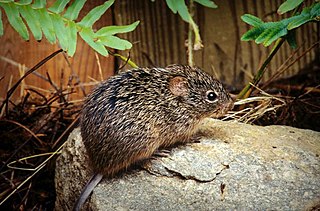Brucepattersonius is a genus of rodents within the tribe Akodontini from southeastern South America. Also known as brucies, the genus is named after Bruce Patterson, MacArthur Curator at the Department of Zoology (Mammals), at the Field Museum of Natural History, Chicago.

The rodent subfamily Sigmodontinae includes New World rats and mice, with at least 376 species. Many authorities include the Neotominae and Tylomyinae as part of a larger definition of Sigmodontinae. When those genera are included, the species count numbers at least 508. Their distribution includes much of the New World, but the genera are predominantly South American, such as brucies. They invaded South America from Central America as part of the Great American Interchange near the end of the Miocene, about 5 million years ago. Sigmodontines proceeded to diversify explosively in the formerly isolated continent. They inhabit many of the same ecological niches that the Murinae occupy in the Old World.

Akodontini is the second most speciose rodent tribe of the subfamily Sigmodontinae. It includes at least 106 living species in 19 genera and is distributed mainly in the southern half of South America, with only two genera extending into Guyana (Podoxymys) and Venezuela (Necromys). It also includes genera previously placed in tribe Scapteromyini. The following genera are now generally recognized:
The Andean rat, or white-tailed akodont, is the only species in the genus Lenoxus. It is a rodent in the tribe Akodontini found on the eastern slopes of the Andes of eastern Peru and western Bolivia. Examination of its genome shows that this species is not closely related to Oxymycterus as had previously been thought, but is quite distinct, having diverged from the other Akodontini soon after the basal radiation of the entire group.

Oxymycterus is the genus of hocicudos. They are rat-like animals endemic to South America. As of April 2019 it included 16 species.
The Caparaó hocicudo is a rodent species from South America. It is endemic to Brazil where it is found in the Pico da Bandeira mountain range.

The long-nosed hocicudo is a South American rodent species found in southeastern Brazil and Uruguay.
Robert's hocicudo is a rodent species from South America. It is found in Brazil and Paraguay.
The red hocicudo is a rodent species from South America. It is found in Argentina, Brazil and Uruguay.
The shining thicket rat is a species of rodent in the family Muridae.
The Argentine hocicudo is a species of rodent in the family Cricetidae. It is found only in northern Argentina in yungas habitat. The exact population is unknown as only three specimens have been collected and threats may be deforestation and overgrazing although the exact effects are unknown. Some authorities consider it to be conspecific with Oxymycterus paramensis, while others consider it distinct.
The spy hocicudo is a species of rodent in the family Cricetidae. It is found only in Paraguay.
The small hocicudo is a little known species of rodent in the family Cricetidae. It is found in Bolivia and Peru on the eastern slopes of the Andes.
Oxymycterus hucucha, also known as the Quechuan Hocicudo, is a species of rodent in the genus Oxymycterus of family Cricetidae from South America. It is found only in a small region of the Andes in central Bolivia, where it lives in cloud forest at altitudes from 2600 to 3000 m.
The Incan hocicudo is a species of rodent in the family Cricetidae. It is found in Bolivia and Peru.
The Paramo hocicudo is a species of rodent in the family Cricetidae. It is found in Argentina, Bolivia, and Peru. The Argentine hocicudo is sometimes considered conspecific.

Ontocetus is an extinct genus of walrus, an aquatic carnivoran of the family Odobenidae, endemic to coastal regions of the southern North Sea and the southeastern coastal regions of the U.S. during the Miocene-Pleistocene. It lived from 13.6 mya—300,000 years ago, existing for approximately 13.3 million years.
The Atlantic Forest hocicudo is a species of rodent in the family Cricetidae. It is found only in southeastern Brazil, where it lives in the Atlantic Forest and associated wetlands at altitudes from sea level to 800 m (2,600 ft).
Cook's hocicudo is a species of rodent in the family Cricetidae. It is found only in southern Uruguay, where it lives in wetlands, moist grasslands and scrub. The specifies is named after American zoologist Joseph “José” A. Cook.

Albicetus is a genus of stem-sperm whales that lived during the Miocene Epoch, around 15 million years ago, and was discovered in Santa Barbara, California in 1909. It was categorized for decades as belonging to a group of extinct walruses erroneously thought to be sperm whales. It was named Albicetus, meaning "white whale", is a reference to the leviathan in Herman Melville's classic 1851 novel Moby-Dick.





